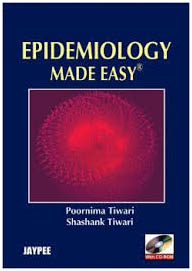
Definition of ‘Epidemiology’
The study of distribution and determinants of health related states in specified populations and the application of this study to control the health problems.
Aims of Epidemiology
1. Describing disease and health related events in specified populations
2. Understanding causation of disease and
3. To provide data for planning of health services
Types of data:
I. Qualitative-
A. Nominal, where the categories are not in any order or hierarchy e.g. Blood groups A, B, AB and O
B. Ordinal, when the categories are in an order e.g. mild, moderate and severe
II. Quantitative-
A. Continuous: where the readings are on a scale and one can get values in decimals also e.g. height, weight
B. Discreet: where the values of individual readings are in whole numbers only e.g. number of children, number of students
Association:
Association is defined as “Concurrence or co-occurrence of tow variables more often than would be expected by chance”.
E.g. male gender and haemophilia
P-value: value of the probability of the ‘Null Hypothesis” being true.
Hill’s criteria for Causation:
1. Temporal association (time)
2. Strength of association (strength)
3. Consistency of association (consistent)
4. Biological plausibility – not a necessary criterion (biological)
5. Specificity of association – not a necessary criterion (specific)
6. Coherence of association (coherence)
E.g. smoking as a cause for lung cancer satisfies all the criteria except for ‘specificity’.
Mnemonic: It’s time for consistentstrength and coherence for a specific and biologicalcause
Risk Factor:
A characteristic or exposure that is associated with the outcome. In other words it’s presence increases the chance (risk) of having the outcome e.g. obesity is a ‘risk factor’ for cardiovascular disease.
Relative Risk (RR):
It measures the strength of the association between two variables
It tells how many times is n exposed person is likely to get the disease as compared to the non- exposed
Formula is: (incidence among exposed)/(incidence among non-exposed)
Incidence:
It is number of NEW cases occurring in a defined population during a specified period of time.
Formula of Incidence:
(no.of NEW cases in a defined population during a specified time period )/(Population at risk during the same time period) X 1000
Prevalence:
It refers to ALL the cases (old and new) present in a population at a given period of time.
Formula of prevalence:
(no.of All cases in a defined population during a specified time period )/(mid-interval population at risk) X 1000
References:
Tiwari P. Epidemiology Made Easy. New Delhi: Jaypee Brothers; 2003
Gordis, L. (2014). Epidemiology (Fifth edition.). Philadelphia, PA: Elsevier Saunders.
Bonita, R., Beaglehole, R., Kjellström, T., & World Health Organization. (2006). Basic epidemiology. Geneva: World Health Organization.
Schneider, Dona, Lilienfeld, David E (Eds.), 4th ed. Lilienfeld’s Foundations of Epidemiology. New York: Oxford University Press; 2015
K. Park. Principles of Epidemiology and Epidemiologic Methods. In Park’s Textbook of Preventive and Social Medicine. 24th Ed. Jabalpur: Banarasidas Bhanot, 2017: pg 58 – 145
Steps in Investigation of an Epidemic: http://www.ihatepsm.com/blog/epidemiology-steps-investigation-epidemic
Tests of Significance: http://www.ihatepsm.com/blog/epidemiology-tests-significance
Monitoring and Evaluation: http://www.ihatepsm.com/blog/epidemiology-monitoring-and-evaluation
Advantages and Disadvantages of Case Control Studies: http://www.ihatepsm.com/blog/epidemiology-advantages-and-disadvantages-case-control-studies
Advantages and disadvantages of cohort study: http://www.ihatepsm.com/blog/epidemiology-advantages-and-disadvantages-cohort-study
Basic Concepts in Epidemiology: http://www.ihatepsm.com/blog/epidemiology-basic-concepts
Types of Epidemiological Studies: http://www.ihatepsm.com/blog/epidemiology-types-epidemiological-studies
Differences between Case – control and cohort study: http://www.ihatepsm.com/blog/epidemiology-differences-between-case-%E2%80%93-control-and-cohort-study
Uses of epidemiology: http://www.ihatepsm.com/blog/epidemiology-uses-epidemiology
Blinding in Experimental Studies: http://www.ihatepsm.com/blog/blinding-experimental-studies
Evaluation of a Screening Test: http://www.ihatepsm.com/blog/epidemiology-evaluation-screening-test
